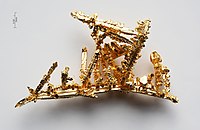
Photo from wikipedia
Abstract Contents of major impurities (Ag, Cu, and Hg) have been studied in gold from ore deposits of various types: (1) associated with skarns and black shales (Altai-Sayan folded area… Click to show full abstract
Abstract Contents of major impurities (Ag, Cu, and Hg) have been studied in gold from ore deposits of various types: (1) associated with skarns and black shales (Altai-Sayan folded area (ASFA) and North Vietnam), (2) pluton-related porphyry Cu-Mo (ASFA), and (3) volcanic pyritic (Rudny Altai, the Urals, and North Vietnam). Analysis of gold ore mineralization in deposits of these types reveals diverse gold compositions along with diverse compositions of productive mineral assemblages. Silver is the most abundant impurity in gold from all fields studied, but its contents vary broadly even within a field type. The content of silver in gold depends not only on its abundance in hydrothermal solutions but also on other independent solution parameters: sulfur fugacity, temperature, salt composition, and pH. The regular decrease in native gold fineness from early to late generations in sulfide ore deposits is related to temperature decrease and large-scale sulfide formation. These processes reduce sulfur fugacity in the solutions and favor silver deposition in native gold rather than in sulfides. Gold of later generations is enriched in mercury in many deposits studied, whereas copper gravitates to earlier, high-temperature ones. In addition to deposition temperature, the contents of copper in gold are determined by its content in hydrothermal solutions, as evidenced by the association of copper-rich gold with basic-ultrabasic, skarn, and porphyry copper deposits. The processes causing the deposition of gold of various chemical compositions are complex. They correlate, to an extent, with gold mineralization temperature, whereas the spectrum of impurities often depends on the belonging of a gold deposit to a certain igneous complex.
Journal Title: Russian Geology and Geophysics
Year Published: 2017
Link to full text (if available)
Share on Social Media: Sign Up to like & get
recommendations!